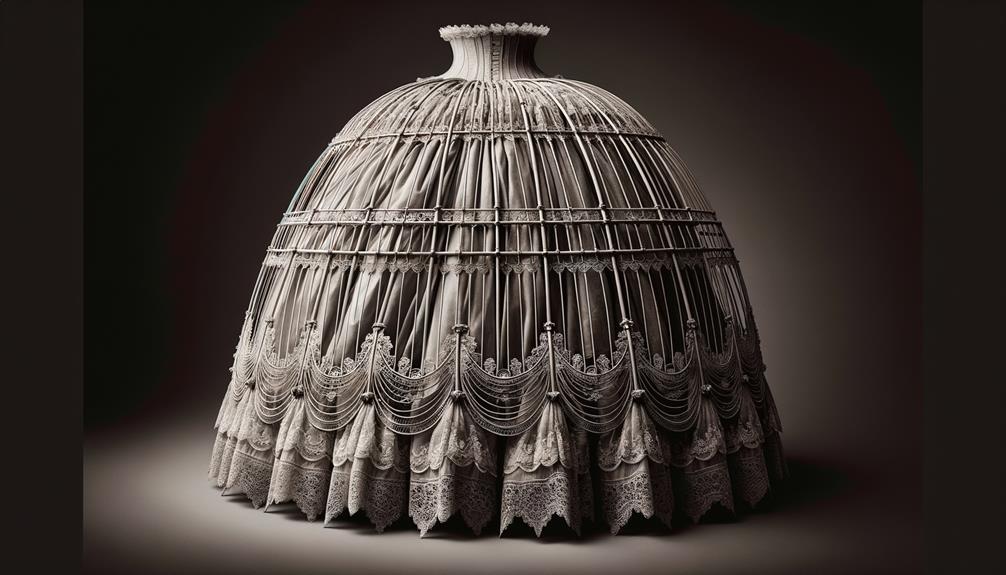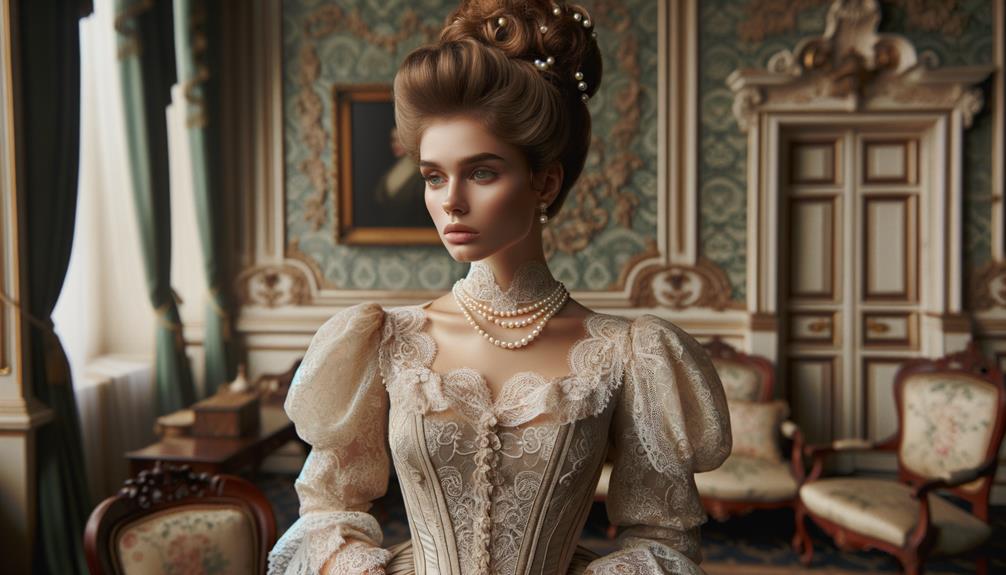Did you know that by the mid-19th century, nearly 75% of women in the Western world wore corsets daily? It's fascinating how such a garment could symbolize both empowerment and oppression. From its ancient origins to its Victorian peak and modern revival, the corset has always been more than just fabric and boning. It's a canvas for societal ideals, gender norms, and personal expression. But what really intrigues me is how this piece of clothing continues to challenge our perceptions of beauty and autonomy. Let's explore how the corset's story is far from over.
The corset has been a contentious and complex symbol throughout history. In the 19th century, the majority of women in the West adopted the corset as a daily accessory, reflecting the era's rigid gender expectations and beauty standards. Yet, some women also found empowerment in the structure and control the corset offered. Today, the corset continues to be a point of discussion, with some embracing it as a form of self-expression, while others view it as a constraint on women's freedom.
Examining the evolution of the corset provides insight into the shifting societal attitudes towards female identity and agency. From its ancient roots to its modern interpretations, the corset's story is intertwined with the ongoing struggle for women's rights and the fluid nature of beauty ideals. By delving into this history, we can gain a deeper understanding of how fashion, culture, and gender norms have intersected over time.
Ancient Origins
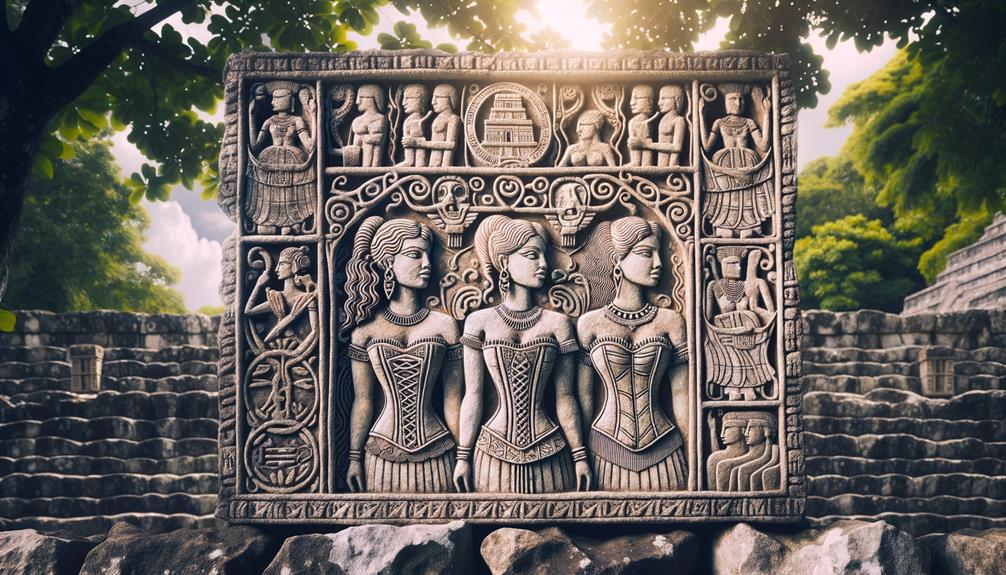
In ancient Crete around 1000 BC, the Minoans wore some of the earliest known corset-like garments, likely for ceremonial purposes. Their art reveals both men and women in tightly fitted clothing, the waist cinched, creating a striking silhouette. This early form of corset wasn't about comfort; it was about ritual and aesthetics.
Ancient Greece saw the evolution of these garments. The Greeks referred to them as 'Zone', made from linen or wool, tightly wrapped around the waist. Unlike the Minoans, the Greeks embraced a more relaxed fit, favoring fluidity over structure. They understood the power of the corset-like garment but interpreted it differently.
During the Middle Ages, comfort and functionality took priority over body shaping. Women of this era didn't prioritize the cinched waist, and the corset-like garments of Minoan and Greek origins faded into obscurity.
Yet, the concept of corsets never fully vanished. It lay dormant, waiting for a cultural shift. These ancient origins, these Minoan and Greek influences, laid the groundwork for a garment that would reemerge, reshaping silhouettes and societies once more. The waist would become a focal point again, but that story belongs to another era.
Renaissance and Baroque
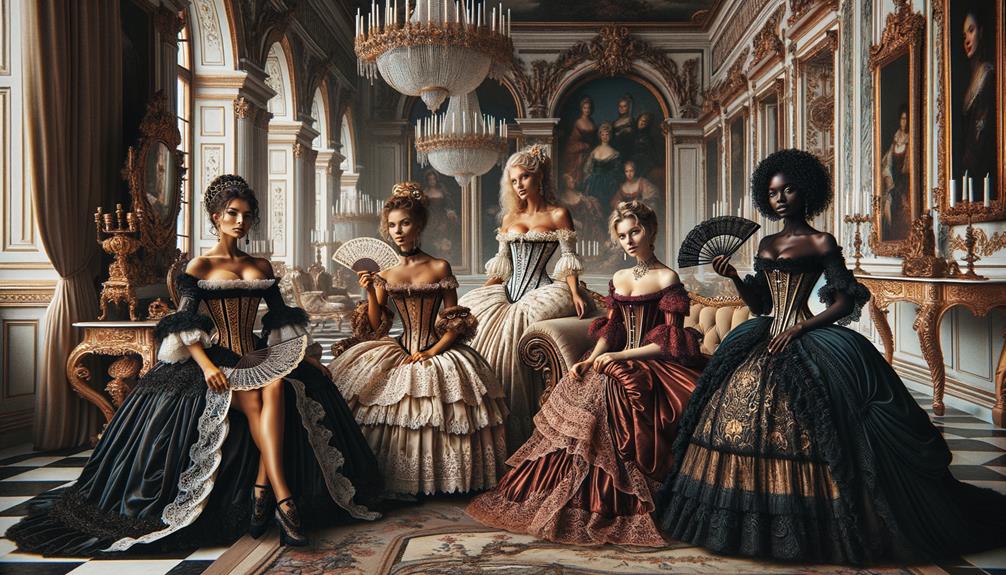
Elegance met structure in the Renaissance and Baroque eras, where corsets sculpted not just bodies but societal ideals. These garments, crafted with layers of stiffened fabric and whale bones, molded the conical torso that epitomized sophistication. The French court embraced these designs, turning waist training into an art form.
Men, too, wore corsets, often with exaggerated codpieces to assert their masculinity. The Minoan snake goddess may have inspired some of these early designs, though the Renaissance and Baroque versions were much more structured and confining.
I reflect on how the corset, a garment both revered and criticized, drew lines between elegance and oppression. Critics argued its health impacts and moral implications, yet it remained a fashion staple. The corset's dual nature is fascinating – both a tool of empowerment and a symbol of restraint.
Today, designer Vivienne Westwood channels this dichotomy, reimagining the corset as a modern statement that blends historic rigidity with contemporary rebellion. Her designs echo the past but speak to a future unbound by the constraints of tradition.
The Renaissance and Baroque corset, much like today's fashion, was a canvas of cultural expression and contradiction.
Victorian Era
The Victorian corset, with its steel busks and tight lacing, encapsulated the era's fixation on the hourglass figure. Waist-cinching corsets became the norm, their design enabling a silhouette that commanded attention and admiration. These corsets were crafted with materials like whalebone or wood, providing the necessary stiffness to mold the body into an idealized form.
In the Victorian era, corsets evolved beyond mere garments; they became symbols of societal expectations and constraints. The term 'strait-laced' arose, reflecting how tightly these corsets were cinched, often at the expense of comfort and health. Breathing was restricted, organs displaced, yet the pursuit of the hourglass figure persisted. The design and construction of corsets bore witness to the lengths society would go to impose a physical ideal.
Reflecting on this, one can't help but be impressed by the innovation involved in their making, despite their controversial impact. As the 19th century waned, the restrictive designs faced criticism and decline. The 'New Woman' movement called for looser, more liberating fashions, signaling an end to the era of the tightly-laced Victorian corset. The journey of the corset had reached a pivotal moment.
Edwardian Innovations
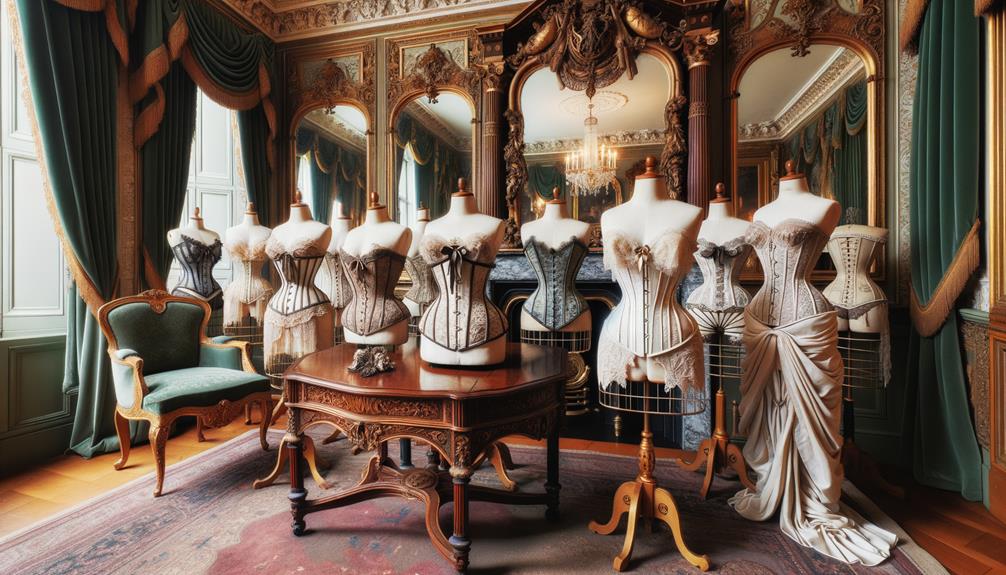
The Edwardian corset brought remarkable changes. It prioritized health and comfort with its flexible materials and straight-fronted design. This era's innovations led to a softer silhouette and a more natural form.
The corset design during the Edwardian period shifted to emphasize well-being and ease. The flexible materials and straight-front style created a gentler, more natural shape. These innovations of the time period resulted in a more comfortable and flattering silhouette for wearers.
Health and Comfort Advancements
Corsets were not always the uncomfortable devices some might assume. In the Edwardian era, they underwent significant redesigns to prioritize health and comfort. Softer materials and lighter boning replaced the rigid structures of the past, reducing physical discomfort and potential health risks.
Edwardian corset makers introduced the straight-fronted busk, which redistributed pressure away from the abdomen, promoting a more natural posture. This was a departure from the severe constriction of Victorian designs. By reducing pressure points, these corsets allowed for better mobility and breathability.
Doctors and reformists of the time advocated for these changes, pushing for less restrictive styles. They understood that overly tight corsets could impair circulation and organ function. The Edwardian S-bend silhouette emerged as a healthier alternative, providing the desired shape without extreme hourglass constriction.
These innovations marked a pivotal step, demonstrating that fashion could evolve to embrace both style and well-being. The balance between aesthetics and comfort represented a significant shift in the history of corsetry.
Silhouette and Style Evolution
Edwardian corsets embraced a more fluid silhouette, blending style with newfound comfort. These corsets featured a straight-fronted busk, creating the famed S-bend shape. This design reduced abdominal pressure, allowing for greater ease and natural movement.
The incorporation of a flat piece of whalebone and shoulder straps provided additional support, making the waist appear smaller without the intense constriction of previous eras. Pads exaggerated the bust, hips, and bum, aligning with the fashionable silhouettes of the time. This evolution in design marked a significant departure from Victorian stiffness.
Edwardian corsets caused a stir in the fashion world. They symbolized a move towards freedom while maintaining elegance. Interestingly, corsets in 1939 caused even more dramatic shifts, hinting at the decline of traditional corsetry.
The S-bend corset has influenced fashion since its inception, its legacy echoed in modern shapewear. Embracing both form and function, it stands as an enduring embodiment of the timeless desire for innovation in fashion.
Material and Design Changes
Edwardian corsets broke from rigid designs, using flexible materials and less boning for comfort. This marked a departure from the constraints of the past. The straight-fronted corset, a hallmark of the era, aimed to reduce abdominal pressure and create the fashionable S-bend silhouette. These corsets accentuated natural curves rather than drastically reshaping the torso.
Three key elements defined Edwardian innovations:
- Elastic materials: Incorporating elastic offered greater flexibility and comfort, foreshadowing the rise of girdles.
- Reduced boning: Unlike predecessors, Edwardian corsets featured less boning, allowing for more natural movement and a softer fit.
- Enhanced silhouettes: Pads, often paired with these corsets, exaggerated the bust, hips, and bum, creating the desired look without excessive tightness.
The Edwardian corset blended tradition and modernity, reflecting a desire for innovation. It wasn't just about following fashion; it was about redefining comfort and aesthetics. The era's designs highlighted a woman's natural beauty, setting the stage for future advancements in women's undergarments.
20th Century Changes
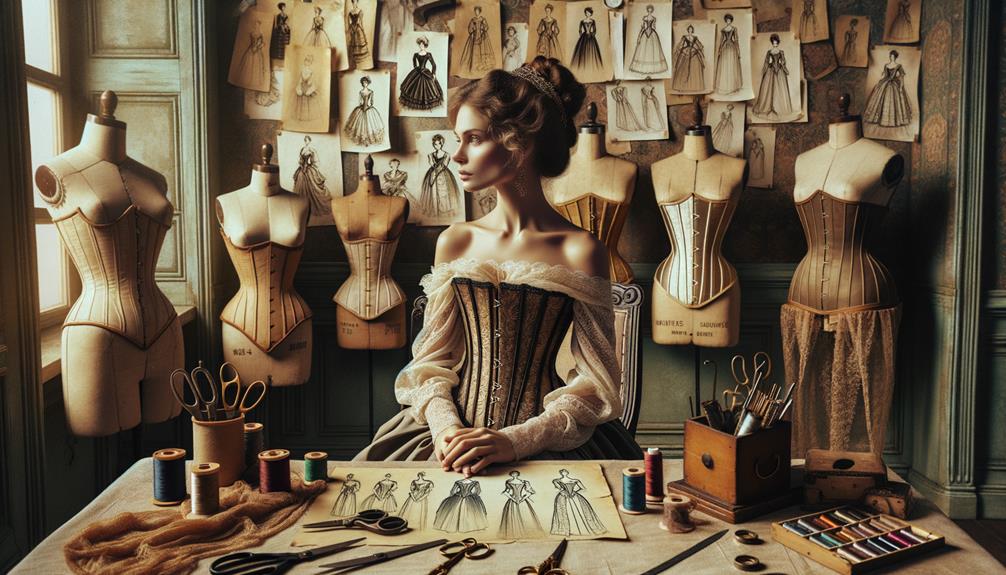
During the 18th century, corsets evolved into a conical shape, enforcing a rigid posture and an idealized silhouette. These corsets were designed as an inverted cone, sculpting torsos into sharp V's. Women wore these corsets to achieve an upright, shoulders-back stance, embodying a poised elegance.
As the Edwardian era arrived, the straight-fronted busk corset became popular. Designed to reduce abdominal pressure, it introduced the distinctive S-bend silhouette, a departure from the rigid conical forms of the past. Pads were added to exaggerate the bust, hips, and rear, aligning with the period's fashion ideals.
| Time Period | Corset Shape |
|---|---|
| 18th Century | Inverted Conical |
| Edwardian Era | S-bend Silhouette |
| Post-Edwardian | S-bend Silhouette |
| Early 20th Century | Exaggerated Bust/Hip |
World War II marked another shift, as corsets became less prevalent, making room for more practical undergarments. It wasn't until designers like Jean Paul Gaultier reimagined the corset that it returned to the spotlight, blending form with function. Once again, the corset stood as a symbol of both tradition and modernity, challenging and redefining societal norms.
Modern Revival

Corsets have made a comeback in fashion, shaping both trends and wardrobes. It's fascinating to see how they balance aesthetics and comfort, heavily influenced by media portrayals. This modern revival has sparked a new debate: are corsets empowering or just another form of constraint?
The resurgence of corsets raises questions about their role in contemporary fashion. On one hand, they can be seen as a way for individuals to reclaim control over their bodies and express themselves. The form-fitting design can be both stylish and confidence-boosting. However, some view corsets as a continuation of restrictive gender norms and oppressive beauty standards.
Ultimately, the debate around corsets highlights the complexities of fashion and its societal implications. As with any trend, people will have differing perspectives on whether this revival is liberating or limiting. It's a nuanced discussion that speaks to broader conversations about personal choice, self-expression, and the evolving role of traditional garments in modern wardrobes.
Contemporary Fashion Trends
Corsets have made a surprising comeback in contemporary fashion, blending history and modernity. Throughout the centuries, women's styles have constantly evolved, and the iconic corset is no exception. Designers like Vivienne Westwood have played a pivotal role in this revival, merging the structured elegance of corsets with today's aesthetics.
Corsets are no longer confined to formal attire or full skirts. They now appear in diverse contexts and materials. This resurgence isn't just about nostalgia; it's about adapting an iconic element to fit the modern wardrobe.
Corsets today offer versatility and self-expression. They are:
- Incorporated into dresses and tops, providing a structured silhouette that pairs well with casual and contemporary styles.
- Worn confidently as both outerwear and lingerie, reflecting changing attitudes.
- Available in a vast range of fabrics, from leather to high-tech textiles, catering to different tastes and aesthetics.
The accessibility in various sizes, colors, and patterns makes corsets adaptable, allowing anyone to wear them and make a unique fashion statement.
Health and Comfort
Modern corsets offer unexpected benefits for posture and back support. Many women today report improved posture and reduced back pain. This type of corset, often misunderstood, is engineered to provide back support and enhance spinal alignment. It's fascinating how this garment, which has origins in the Minoan era, has evolved over time.
Corsets began as restrictive fashion pieces, but now, they're tools that can be integrated into a healthy lifestyle. Properly fitted, they don't restrict breathing or harm internal organs. Corsets were not needed for everyone, but for some, they offer significant relief and confidence. Waist training, a modern practice, allows gradual waist reduction over time, highlighting the versatility of these garments.
Reflecting on the historical context, the modern revival of corsets represents innovation. They serve those who seek both aesthetic appeal and functional benefits. As long as precautions and breaks are observed, corsets can be a comfortable, healthful addition to one's wardrobe. In this respect, the corset has transcended its origins to become a symbol of both style and support.
Influences From Media
Madonna's iconic corset-clad performances in the '90s revived the garment as a symbol of empowerment and rebellion. This resurgence in women's fashion marked a pivotal moment in the history of corsets. No longer just undergarments, corsets became popular in mainstream media and various subcultures.
Three key influences in the modern corset revival include:
- Fetish and BDSM depictions: Media like the Fifty Shades franchise showcased corsets as lifestyle items, intertwining them with notions of power and control.
- Celebrity endorsements: The Kardashian-Jenner family, with their corset-inspired attire, propelled the trend into high fashion. Their influence made corsets commonly worn by a wide audience.
- Subcultural aesthetics: Steampunk and goth communities have embraced corsets, integrating them into their distinctive looks. This group has further popularized the garment, showcasing its versatility and appeal.
Social media has amplified these trends. Influencers promote waist training, sparking debates about beauty standards and body modification. Corsets, once a relic, now symbolize more than just fashion – they reflect a complex interplay of identity, culture, and empowerment.
Frequently Asked Questions
What Does the Corset Symbolize?
The corset has a complex history, shifting from a tool of suppression to a symbol of empowerment. It's a fascinating paradox that demonstrates how fashion can redefine personal and societal boundaries. For some, the corset represents control and constraint, while for others, it symbolizes liberation and self-expression. This garment's evolving meaning reflects the changing attitudes and power dynamics within society. Ultimately, the corset's symbolism is multifaceted, encapsulating both the restrictive and the liberating aspects of fashion and its impact on individual and collective experiences.
What Did Corsets Do to Women's Bodies?
Corsets put immense pressure on my body. They squeezed my lungs, warped my ribs, and shifted my organs to an unnatural position. This forced me into a shape that society deemed beautiful, but the consequences were severe. My physical freedom was sacrificed to meet societal standards of appearance. The toll on my health was too high a price to pay.
Why Are Corsets Sexualised?
Corsets have become sexualized over time due to their ability to accentuate an hourglass figure and their historical association with themes of submission and domination. The revealing nature of corset designs, coupled with their connections to sex work and BDSM practices, has contributed to an erotic perception of these garments. This blurring of private and public boundaries enhances the corset's allure as a sexually charged item of clothing.
Conclusion
The corset's journey through history is like a river, constantly shifting and evolving. Each era has left its mark, shaping its course from ancient practices to modern trends. The corset has been both a shackle and a shield, reflecting our complex relationship with identity and personal freedom. Today, people might don the corset less to conform and more as an act of defiance.
In its tight embrace or liberating release, the corset reminds us that our bodies are canvases, and our stories are etched in the fabric and steel that envelop them. It's a symbol that continues to captivate and inspire, challenging our notions of beauty, power, and self-expression.


